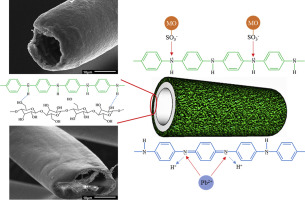当前位置:
X-MOL 学术
›
Mater. Chem. Phys.
›
论文详情
Our official English website, www.x-mol.net, welcomes your feedback! (Note: you will need to create a separate account there.)
Adsorption of anionic methyl orange dye and lead(II) heavy metal ion by polyaniline-kapok fiber nanocomposite
Materials Chemistry and Physics ( IF 4.6 ) Pub Date : 2020-03-01 , DOI: 10.1016/j.matchemphys.2020.122682 Rontgen B. Gapusan , Mary Donnabelle L. Balela
Materials Chemistry and Physics ( IF 4.6 ) Pub Date : 2020-03-01 , DOI: 10.1016/j.matchemphys.2020.122682 Rontgen B. Gapusan , Mary Donnabelle L. Balela

|
Abstract Low value natural hollow kapok fibers (KpF) were utilized as support for the synthesis of highly efficient polyaniline (PANI)-based adsorbents for heavy metal and ionic dye pollutants. The PANI-kapok (PANI-KpF) nanocomposite was prepared via in situ polymerization of aniline monomer in acidic condition using ammonium persulfate (APS) as the oxidizing agent. The morphology, wetting property and adsorption capacity of the PANI-KpF nanocomposites were tailored by performing NaClO2 pre-treatment and varying the APS to aniline ratio during coating. NaClO2 pre-treatment was found to promote the adhesion of aniline monomer on the surface of kapok, leading to high quality coating. On the other hand, the nanocomposite with [APS]/[aniline] = 1.4 exhibited the highest adsorption capacity. The effects of adsorbent dosage, initial solution pH, contact time, initial dye and heavy metal concentrations, and temperature were investigated through batch adsorption experiments. Kinetic studies indicate that the adsorption of MO and Pb(II) onto the PANI-KpF nanocomposite agrees well with the pseudo-second order kinetic model. Equilibrium isotherm studies show that the adsorption of both model pollutants follows the Langmuir isotherm model, and the calculated monolayer adsorption capacities are 136.75 and 63.60 mg/g for MO and Pb(II), respectively. Thermodynamic studies reveal that the adsorption of MO and Pb(II) are both endothermic and spontaneous.
中文翻译:

聚苯胺-木棉纤维纳米复合材料对阴离子甲基橙染料和铅(II)重金属离子的吸附
摘要 利用低价值天然中空木棉纤维 (KpF) 作为合成高效聚苯胺 (PANI) 基吸附剂的载体,用于重金属和离子染料污染物。PANI-木棉(PANI-KpF)纳米复合材料是通过苯胺单体在酸性条件下使用过硫酸铵(APS)作为氧化剂原位聚合制备的。PANI-KpF 纳米复合材料的形态、润湿性和吸附能力是通过进行 NaClO2 预处理和在涂层过程中改变 APS 与苯胺的比例来定制的。发现 NaClO2 预处理可促进苯胺单体在木棉表面的附着力,从而产生高质量的涂层。另一方面,[APS]/[苯胺] = 1.4 的纳米复合材料表现出最高的吸附容量。吸附剂用量、初始溶液 pH 值的影响 通过批量吸附实验研究了接触时间、初始染料和重金属浓度以及温度。动力学研究表明 MO 和 Pb(II) 在 PANI-KpF 纳米复合材料上的吸附与伪二级动力学模型非常吻合。平衡等温线研究表明,两种模型污染物的吸附都遵循朗缪尔等温线模型,计算出的单层吸附容量分别为 136.75 和 63.60 mg/g 对 MO 和 Pb(II)。热力学研究表明,MO 和 Pb(II) 的吸附都是吸热和自发的。动力学研究表明 MO 和 Pb(II) 在 PANI-KpF 纳米复合材料上的吸附与伪二级动力学模型非常吻合。平衡等温线研究表明,两种模型污染物的吸附都遵循朗缪尔等温线模型,计算出的单层吸附容量分别为 136.75 和 63.60 mg/g 对 MO 和 Pb(II)。热力学研究表明,MO 和 Pb(II) 的吸附都是吸热和自发的。动力学研究表明 MO 和 Pb(II) 在 PANI-KpF 纳米复合材料上的吸附与伪二级动力学模型非常吻合。平衡等温线研究表明,两种模型污染物的吸附都遵循朗缪尔等温线模型,计算出的单层吸附容量分别为 MO 和 Pb(II) 的 136.75 和 63.60 mg/g。热力学研究表明,MO 和 Pb(II) 的吸附都是吸热和自发的。
更新日期:2020-03-01
中文翻译:

聚苯胺-木棉纤维纳米复合材料对阴离子甲基橙染料和铅(II)重金属离子的吸附
摘要 利用低价值天然中空木棉纤维 (KpF) 作为合成高效聚苯胺 (PANI) 基吸附剂的载体,用于重金属和离子染料污染物。PANI-木棉(PANI-KpF)纳米复合材料是通过苯胺单体在酸性条件下使用过硫酸铵(APS)作为氧化剂原位聚合制备的。PANI-KpF 纳米复合材料的形态、润湿性和吸附能力是通过进行 NaClO2 预处理和在涂层过程中改变 APS 与苯胺的比例来定制的。发现 NaClO2 预处理可促进苯胺单体在木棉表面的附着力,从而产生高质量的涂层。另一方面,[APS]/[苯胺] = 1.4 的纳米复合材料表现出最高的吸附容量。吸附剂用量、初始溶液 pH 值的影响 通过批量吸附实验研究了接触时间、初始染料和重金属浓度以及温度。动力学研究表明 MO 和 Pb(II) 在 PANI-KpF 纳米复合材料上的吸附与伪二级动力学模型非常吻合。平衡等温线研究表明,两种模型污染物的吸附都遵循朗缪尔等温线模型,计算出的单层吸附容量分别为 136.75 和 63.60 mg/g 对 MO 和 Pb(II)。热力学研究表明,MO 和 Pb(II) 的吸附都是吸热和自发的。动力学研究表明 MO 和 Pb(II) 在 PANI-KpF 纳米复合材料上的吸附与伪二级动力学模型非常吻合。平衡等温线研究表明,两种模型污染物的吸附都遵循朗缪尔等温线模型,计算出的单层吸附容量分别为 136.75 和 63.60 mg/g 对 MO 和 Pb(II)。热力学研究表明,MO 和 Pb(II) 的吸附都是吸热和自发的。动力学研究表明 MO 和 Pb(II) 在 PANI-KpF 纳米复合材料上的吸附与伪二级动力学模型非常吻合。平衡等温线研究表明,两种模型污染物的吸附都遵循朗缪尔等温线模型,计算出的单层吸附容量分别为 MO 和 Pb(II) 的 136.75 和 63.60 mg/g。热力学研究表明,MO 和 Pb(II) 的吸附都是吸热和自发的。


























 京公网安备 11010802027423号
京公网安备 11010802027423号